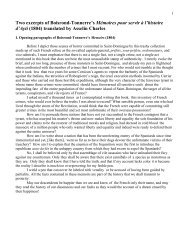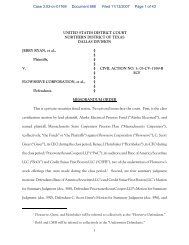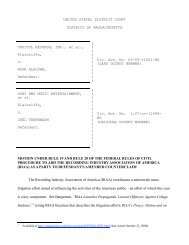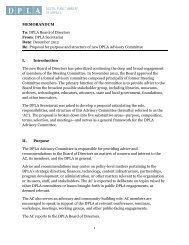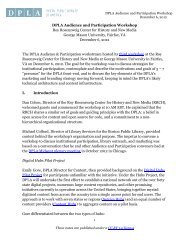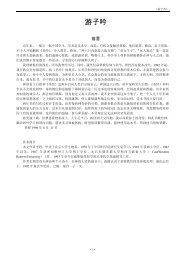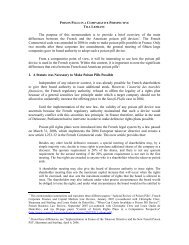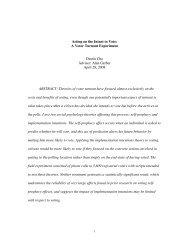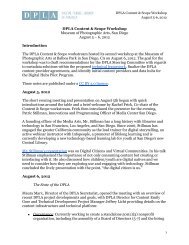Boisrond-Tonnerre's Mémoires (1804) online. - Harvard University
Boisrond-Tonnerre's Mémoires (1804) online. - Harvard University
Boisrond-Tonnerre's Mémoires (1804) online. - Harvard University
You also want an ePaper? Increase the reach of your titles
YUMPU automatically turns print PDFs into web optimized ePapers that Google loves.
Jean Jonassaint, Syracuse <strong>University</strong><br />
A Very Historic Moment in Caribbean Studies: <strong>Boisrond</strong>-Tonnerre’s <strong>Mémoires</strong><br />
(<strong>1804</strong>) <strong>online</strong><br />
Although originally published in <strong>1804</strong> in Dessalines (then capital of Hayti), it is with<br />
their second edition by Saint-Remy (Paris, 1851), that <strong>Boisrond</strong>-Tonnerre’s <strong>Mémoires</strong><br />
were passed on to posterity.<br />
Until recently, misled by Saint-Remy’s remarks on the rarity of the book and his<br />
difficulties in tracing a single copy in good condition in the 1840s (<strong>Boisrond</strong>-Tonnerre<br />
1851, vii), it was generally incorrectly assumed that the original edition was no longer<br />
available, or perhaps never even existed as Raphaël Berrou and Pradel Pompilus claimed<br />
in their Manuel d’histoire de la littérature haïtienne (1961, 25-26). Decades later, it was<br />
also Marlene Daut’s first conclusion as she states in an article on <strong>Boisrond</strong>-Tonnerre and<br />
de Vastey: “I have not been able to find an original copy of the <strong>1804</strong> text in any libraries<br />
in the U.S., France or Haiti. This caused me to momentarily question whether or not the<br />
memoir was published at all before 1851” (2008, 57 note 13).<br />
Yet Saint-Remy, in his “historical and critical study” of <strong>Boisrond</strong>-Tonnerre’s text,<br />
explicitly refers to the edition of <strong>1804</strong>, and Beaubrun Ardouin in volume 6 of Études sur<br />
l’histoire d’Haïti states that the Memoirs were “written and published in <strong>1804</strong>” (1856,<br />
42). In addition, the <strong>1804</strong> first edition is listed in the Catalogue of the <strong>Harvard</strong> <strong>University</strong><br />
Library in Cambridge, Massachusetts, at least since 1830 (vol. 1, 85). This gift of<br />
Colonel Israel Thorndike (1755-1832), according to <strong>Harvard</strong> reference librarian, Susan<br />
Halpert, based on a note in William Bentinck-Smith’s Building a Great Library: The<br />
Coolidge Years at <strong>Harvard</strong> (1976, 13), most likely dates from 1818 (email to Jean<br />
Jonassaint, May 16, 2013).<br />
If the Dessalines edition is now <strong>online</strong>, it is primarily because Henri Cauvin and<br />
Nicole Xavier Cauvin in 1987 had published a third edition of the Memoirs, which,<br />
except for some typos or omissions, carefully followed the <strong>1804</strong> text, even reproducing<br />
word for word its front cover. This self-published book went unnoticed. But after I read it<br />
in August 2011, I knew there was a copy of the first edition still available. I decided to go<br />
to the source. Thanks to such modern research tools as <strong>online</strong> catalogs, I was able to trace<br />
the unique volume that has probably survived at the Houghton Library of <strong>Harvard</strong>
<strong>University</strong>. It is a reproduction of this very rare document that is now in cyberspace. This<br />
is a great premiere for the Caribbean, and for Haiti in particular.<br />
To really understand the importance of having this volume <strong>online</strong>, we must<br />
remember that it is not listed in Max Bissainthe’s impressive Dictionnaire de<br />
bibliographie haïtienne (1951, 37-38 notice 435), which cites only Saint-Remy’s second<br />
edition, that Bissainthe had found at the New York Public Library and the library of<br />
Saint-Louis de Gonzague (Port-au-Prince). Moreover, even a nineteenth-century historian<br />
such as Beaubrun Ardouin, while stating that the book “was written and published in<br />
<strong>1804</strong>,” only had access to the second edition, as suggested by the following note:<br />
“Memoirs by B. Tonnerre, edited by Mr. Saint-Rémy (sic), p. 23, a note of the author”<br />
(1856, 334 — my translation). That tells us how rarely the first edition was read or<br />
consulted. Indeed, with the exception of Xavier Cauvin and Cauvin (1987), which<br />
follows the text of <strong>1804</strong>, since 1851 each edition or reproduction of the Memoirs follows<br />
Saint-Remy: Fardin’s reprint of 1981, or the 1991 edition prefaced by Pierre Buteau and<br />
Michel Acacia. Therefore, the text that passed to history is not quite that of the Adjutant<br />
General <strong>Boisrond</strong>-Tonnerre, and a part of Haitian historiography and bibliography has<br />
been built on a text only more or less in conformity with the original.<br />
In fact, despite assertions to the contrary in his presentation, Saint-Remy did not<br />
faithfully follow <strong>Boisrond</strong>-Tonnerre’s text. Among many minor silent corrections such as<br />
“Français” rather than “français” or “Haïtiens” rather than “haytiens,” the most<br />
significant variant spelling is “Haiti” rather than “Hayti” in the title. There are also quite<br />
large number of deletions or omissions, such as the incomplete note 2 on page 23,<br />
incorrectly numbered 22 (<strong>1804</strong>, 13-14 note 2). But more significantly, Saint-Remy gives<br />
as the author’s name, simply <strong>Boisrond</strong>-Tonnerre rather than “l’adjudant général<br />
<strong>Boisrond</strong>-Tonnerre.” He cut the last phrase of the front cover of the first edition, “AVEC<br />
LA PERMISSION DE S. E. LE GOUVERNEUR GENERAL, <strong>1804</strong>.” This erasure of the imprimatur<br />
of the army and of the government at the highest level, the head of the state himself, is<br />
very questionable. In part, it elides the official nature of the book, which is reinforced by<br />
the quote of the national motto “LIBERTE OU LA MORT” (FREEDOM OR DEATH) at the top of<br />
the first page of the original text, which is also lacking in the Saint-Remy edition, as well<br />
as the italicized phrase, “An premier de l’indépendance” (First year of independence),
just before the opening of the text itself. By such editorial decisions, consciously or not,<br />
Saint-Remy tends to displace the work from the paradigm of revolutionary and official<br />
discourses in which the Adjutant General wanted to inscribe it, by borrowing (rhetorical<br />
and typographical) features of the first page of the booklet of the Act of Haitian<br />
Independence and other related documents of January 1, <strong>1804</strong>, published by<br />
“l’Imprimerie du Gouvernement” (the Government Printing Office) just like the<br />
Memoires (see figures 1 and 2). Moreover, Saint-Remy modernizes the annotation system<br />
by placing the parenthetical references before the final period rather than after. Finally,<br />
he confesses in a note that contradicts his policy statement at the end of his “Étude”:<br />
“Here, following <strong>Boisrond</strong>-Tonnerre’s Memoirs, pages of the appended correspondence<br />
are missing, the book is mutilated. But we complete this correspondence with the<br />
Ambigu, French collection that was published in London under the direction of Pelletier”<br />
(1851, 100 note 1 — my translation).<br />
Beyond this overview of different editions of the text, of the fortune or misfortune<br />
of its first edition, the big question remains its genesis, some even questioning its<br />
authenticity, as Bissainthe recalls in his notice on the second edition (1951, 37-38).<br />
Indeed, what are the sources for this text? How it was produced? When? In addition to<br />
being the secretary of Dessalines and the writer of the Act of Independence of Haiti, who<br />
is this man born Louis Félix Mathurin <strong>Boisrond</strong> (1776-1806), this author, Adjutant<br />
General <strong>Boisrond</strong>-Tonnerre, who, for the first time in history, systematically and<br />
radically breaks with the dominant Western discourse, rejecting any dialogue with the<br />
French authorities to speak directly to the Haitian people of his time and the future? (See<br />
opening and closing paragraphs of the memoirs in <strong>1804</strong>, 3-4 and 93, English translation<br />
by Asselin Charles.)<br />
Let us bet that putting <strong>online</strong> in May 2013 the <strong>1804</strong> edition, which finally restores<br />
to the entire research community the first volume of the history of the Haitian Revolution<br />
by a forefront witness and actor, opens the way for some decisive rereading that will<br />
shine new lights on the foundations of our modernity.
Selected Bibliography<br />
Ardouin, B. Études sur l’histoire d’Haïti: tome sixième. Paris : Chez l’auteur, 1856.<br />
Ardouin, B. Géographie de l’île d’Haïti. Port-au-Prince [no publisher],1832.<br />
Bissainthe, Max. Dictionnaire de bibliographie haïtienne. Washington: Scarecrow Press,<br />
1951.<br />
<strong>Boisrond</strong>-Tonnerre (l’adjudant général). <strong>Mémoires</strong> pour servir à l’histoire d’Haïti.<br />
Dessalines: Imprimerie du Gouvernement, <strong>1804</strong><br />
.<br />
<strong>Boisrond</strong>-Tonnerre. <strong>Mémoires</strong> pour servir à l’histoire d’Haïti ; précédés de différents<br />
actes politiques dus à sa plume ; et d'une étude historique et critique par Saint-Remy.<br />
Paris: France, libraire, 1851 .<br />
<strong>Boisrond</strong>-Tonnerre. <strong>Mémoires</strong> pour servir à l’histoire d’Haïti. Port-au-Prince: Éditions<br />
Fardin, [1851] 1981.<br />
<strong>Boisrond</strong>-Tonnerre. <strong>Mémoires</strong> pour servir à l’histoire d’Haïti. “Introduction” by Henri<br />
Cauvin and Nicole Xavier Cauvin. Collection Connaissance de l’histoire, vol. 1, [<strong>1804</strong>]<br />
1987.<br />
<strong>Boisrond</strong> Tonnerre, <strong>Mémoires</strong> pour servir à l’histoire d’Haïti. “Préface” by Pierre Buteau<br />
and Michel Acacia. Port-au-Prince: Éditions des Antilles, 1991.<br />
Catalogue of the <strong>Harvard</strong> <strong>University</strong> Library in Cambridge, Massachusetts, vol. 1.<br />
Cambridge: E. W. Metcalf and Company, Printers to the <strong>University</strong>, 1830.<br />
Daut, Marlene. “Un-Silencing the Past: <strong>Boisrond</strong>-Tonnerre, Vastey, and the Re-Writing<br />
of the Haitian Revolution.” South Atlantic Review 74.1 (2008): 35-64<br />
.<br />
F.I.C. [Berrou, Raphaël and Pradel Pompilus.] Manuel d’histoire de la littérature<br />
haïtienne. Port-au-Prince : Henri Deschamps, 1961.<br />
Garraway, Doris ed. Tree of Liberty: Cultural Legacies of the Haitian Revolution in the<br />
Atlantic World. Charlottesville: <strong>University</strong> of Virginia Press, 2008.<br />
Pascal-Trouillot, Ertha and Ernst Trouillot. Encyclopédie biographique d’Haïti.<br />
Montréal: Éditions SEMIS, 2001.<br />
Sannon, Pauléus Horace. <strong>Boisrond</strong>-Tonnerre et son temps, étude historique. Port-au-<br />
Prince: Héraux, 1904.




